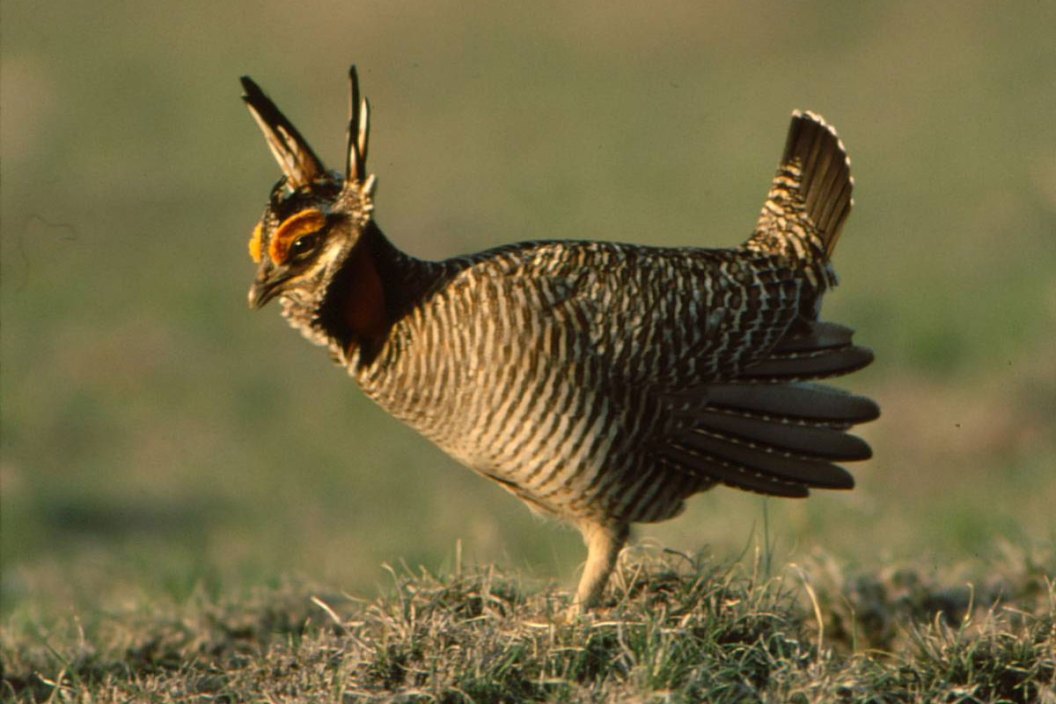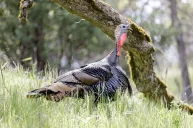The Lesser Prairie-Chicken is a favorite game bird in the western U.S., but its numbers are diminishing.
The lesser prairie-chicken, or Tympanuchus pallidicinctus, is an upland game bird species, known in America as an open grassland-nesting bird native to certain areas of Western Kansas, Southeastern Colorado, Oklahoma, New Mexico, and Texas.
A little smaller and paler than its cousin the Greater Prairie-Chicken, this member of the grouse family is well adapted to the arid short-grass regions of the southern Great Plains, but agriculture and energy exploration is creating a big problem for this bird and the ecosystems it resides in.
Their biggest predators are probably humans and habitat decline, but foxes, coyotes, and even badgers are known to prey on them. Also, raptors pose a threat, especially northern harriers, golden eagles, and great horned owls which can all take a large toll on their local populations as well.
Along with a full description, we'll take a look at recent conservation efforts, including the lesser prairie-chicken initiative, to hopefully learn how we can bring them back in bigger numbers.
Lesser prairie-chicken habitat is a case study representative of what many wildlife species are or will soon be facing. As natural resources decline, wildlife agencies and North American land management practices will need to change to be aware of this once plentiful game bird to ensure its survival into the future.
The Lesser Prairie-Chicken
When we think of grouse and grouse hunting, we don't always consider that a member of this species might live in the open grasslands of America's western half. Even south into Texas and New Mexico there are populations of lesser prairie-chickens, but those numbers have been on the decline for some time now.
The lesser prairie-chicken has a barred "stripe" pattern with a gray-brown and white look which camouflages it well from predators. This grouse is quite chicken-like in its appearance due to its size and shape.
Males have a tuft of feathers on their heads that looks almost like a crown. When they raise their neck feathers to expose the red skin underneath, they're executing the courtship booming sounds that this species is so well known for.
In the spring of the year, at sunrise and again in the evening, males gather on a "lek" or "booming ground" to display themselves and attract females. When they display, the males raise their feather tufts on their necks, and stamp their feet rapidly all while making hollow cackling sounds and leaping in the air loudly.
The females have similar features, but with a short tail, small head, pale throat, and a line around their eye. The females are made more drab to be less exposed while nesting and certainly don't have the same ornamentation that the males have.
They are known to live in resident shortgrass prairies on sandy soils where shinnery oak, sand sagebrush, and bluestem grasses are the main source of vegetation.
Nest sites are on the ground, usually under any shrub or clump of grass. The Nest is built by the female and is a shallow depression lined with a few bits of grass, weeds, or other natural materials.
Females lay anywhere from 10-15 eggs of a whitish pale to brown and olive speckled eggs that incubate for about 25 days. Once the young hatch, they almost immediately leave the nest and are attended by their mother, but they feed themselves.
Their diet consists of many things found in and around their home range including insects like grasshoppers and beetles, acorns, seeds and plants such as oak leaves. One positive byproduct of agricultural expansion in lesser prairie-chicken habitat is that the lesser prairie-chicken eats a lot of waste grain around farm fields, particularly in the fall and winter.
Conservation Status of the Lesser Prairie-Chicken
According to The Cornell Lab, "The Lesser Prairie-Chicken was listed by the federal government as a threatened species in March 2014, making hunting the birds illegal (limited hunting had previously been allowed in Kansas and Texas). However, a change in administrations in the U.S. government led to the annulment of this listing in July 2016, and hunting of this extremely scarce species is once again permitted by law."
Certainly, it is a part of a hunter's conservationist heart to make his or her own decision whether or no to hunt a bird whose species has diminished so much. However, knowing that outdoorsmen and women nationwide are at the forefront of efforts to create and establish new guidelines to help this venerable species, it is no wonder that initiatives like the Conservation Reserve Program, (CRP) and the Lesser Prairie-Chicken Initiative are at the leading edge of making this species viable again.
Attempts in areas of need to improve grassland habitat have been successful, "including efforts to increase native plant cover, and to use prescribed burning to create additional lek sites or to improve plant cover and insect numbers in nesting habitat."
The Lesser Prairie-Chicken population has lost over 90 percent of its overall historical numbers, largely due to the destruction, modification, and overgrazing of its native prairie habitat.
Lesser Prairie-Chicken Initiative
The Natural Resources Conservation Service (NRCS) established the Lesser Prairie-Chicken Initiative (LPCI) back in 2010. This organization works by creating a partnership of ranchers, agencies, universities, non-profit groups, and businesses that embrace the common vision of wildlife conservation through sustainable ranching and agriculture.
This gives farmers and ranchers the incentive they need to grow their crops profitably, while receiving technical and financial help through the partnership for ranchers that restore and protect habitat for the prairie chicken.
The LPCI helps both landowners and the lesser prairie-chicken by organizing conservation planning, burning prescribed fires, putting sustainable grazing systems in place, removing woody plants, managing drought circumstances, and helping with CRP technical support.
It's not easy, but long-time ranchers in Texas, Kansas, New Mexico, and Oklahoma have turned their family ranches into sustainable prairie-chicken habitat by having open minds towards their plight. In this way, many have found that what is good for the lesser prairie-chicken can be good for the ranch.
For instance, on the Hashknife Ranch in Kansas, Ed Koger has had both a robust cattle operation and a thriving population of lesser prairie-chickens for many years thanks to calculated, prescribed burns and a strong reliance on LPCI assistance and guidance.
The Lesser Prairie-Chicken Now and in the Future
As the LPCI states, "With 95% of lesser prairie-chicken habitat located on private lands, empowering landowners to improve rangelands is essential to conserving and expanding lesser prairie-chicken populations."
Lesser prairie-chickens were once abundant across more than 180,000 square miles of western and southwestern America, but their distribution has been reduced by more than 85 percent. That loss is due in large part to habitat loss and other land fragmentation.
According to the U.S. Fish and Wildlife Service (USFWS), in July, 2016, the lesser prairie-chicken was removed from the Federal List of Endangered and Threatened Wildlife, which was a positive development. But their plight is not over yet.
With trusted organizations in place and a better understanding of what works, landowners have a resource that can make a real difference.
Even with their range diminished in some regions, the lesser prairie-chicken is expanding in others thanks to sportsmen and women, ranchers, and organizations across the U.S.
For hunting gear and more, check out Bass Pro Shops.
Looking for a little more or even hot lunch for your hunting blind? Follow my webpage, or on Facebook and Twitter.
NEXT: BOBCAT FACTS: HOW MUCH DO YOU KNOW ABOUT NORTH AMERICA'S FELINE PREDATOR?
WATCH





